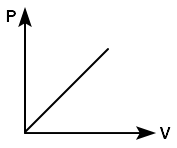In thermodynamic processes, which of the following statements is not true?
| 1. | In an adiabatic process, the system is insulated from the surroundings. |
| 2. | In an isochoric process, the pressure remains constant. |
| 3. | In an isothermal process, the temperature remains constant. |
| 4. | In an adiabatic process, \(P V^\gamma\) = constant. |
A polyatomic gas \(\left(\gamma = \frac{4}{3}\right)\) is compressed to \(\frac{1}{8}\) of its volume adiabatically. If its initial pressure is \(P_0,\) its new pressure will be:
| 1. | \(8P_0\) | 2. | \(16P_0\) |
| 3. | \(6P_0\) | 4. | \(2P_0\) |

Match the following:
| Column I | Column II | ||
| \(P\). | Process-I | \(\mathrm{a}\). | Adiabatic |
| \(Q\). | Process-II | \(\mathrm{b}\). | Isobaric |
| \(R\). | Process-III | \(\mathrm{c}\). | Isochoric |
| \(S\). | Process-IV | \(\mathrm{d}\). | Isothermal |
| 1. | \(P \rightarrow \mathrm{a}, Q \rightarrow \mathrm{c}, R \rightarrow \mathrm{d}, S \rightarrow \mathrm{b}\) |
| 2. | \(P \rightarrow \mathrm{c}, Q \rightarrow \mathrm{a}, R \rightarrow \mathrm{d}, S \rightarrow b\) |
| 3. | \(P \rightarrow \mathrm{c}, Q \rightarrow \mathrm{d}, R \rightarrow \mathrm{b}, S \rightarrow \mathrm{a}\) |
| 4. | \(P \rightarrow \mathrm{c}, Q \rightarrow \mathrm{d}, R \rightarrow \mathrm{b}, S \rightarrow \mathrm{a}\) |

1. \(V_1= V_2\)
2. \(V_1> V_2\)
3. \(V_1< V_2\)
4. \(V_1\ge V_2\)
Which of the following graph shows the variation of pressure P with volume V for an ideal gas at a constant temperature?
| 1. |  |
2. |  |
| 3. |  |
4. |  |
Which one of the following processes is reversible?
| 1. | Transfer of heat by radiation |
| 2. | Transfer of heat by conduction |
| 3. | Isothermal compression |
| 4. | Electrical heating of a nichrome wire |
1. \(450~\text{K}\)
2. \(375~\text{K}\)
3. \(225~\text{K}\)
4. \(405~\text{K}\)
Can two isothermal curves cut each other?
| 1. | Never |
| 2. | Yes |
| 3. | They will cut when the temperature is 0°C. |
| 4. | Yes, when the pressure is equal to the critical pressure. |
| 1. | \(64P\) | 2. | \(32P\) |
| 3. | \(\frac{P}{64}\) | 4. | \(16P\) |
The initial pressure and volume of a gas are \(P\) and \(V\), respectively. First, it is expanded isothermally to volume \(4V\) and then compressed adiabatically to volume \(V\). The final pressure of the gas will be: [Given: \(\gamma = 1.5\)]
| 1. | \(P\) | 2. | \(2P\) |
| 3. | \(4P\) | 4. | \(8P\) |






